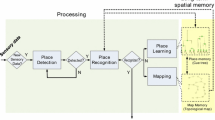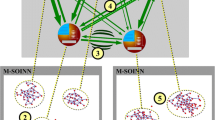Abstract
In this article we discuss a network model, which simulates functionallysome of the features intrinsic to human navigation and the merits ofincorporating such features on a behavior-based robot. Specifically thepaper deals with implementing a memory based reasoning strategy duringreal-time navigation of a mobile robot. For the purpose ofimplementation, memory has been identified with an ability to cognizethe local environment or scenario, classify such scenarios in terms ofpreviously learned primitives or landmarks, remember and recollect suchprimitives at later instants and correlate over time similar experiencesof scenarios. Such memory based reasoning enhances the robot'snavigation capabilities through intelligent decisions due to spatialunderstanding, scene recollection abilities by remembrance and detectinglocal minimum traps through place recognition. A double layeredspatio-temporal classification scheme consisting of a fuzzy rule-basedspatial classifier and a temporal classifier based on self-organizingmap and ART networks are adopted for this purpose. The classifiernetwork reduces the robot's experience of its environment consisting ofa stream of sensor patterns into weight vectors that signify aparticular landmark. An extension of the network architecture is alsointroduced to cognize the presence of dynamic obstacles amidststationary ones.
Similar content being viewed by others
References
Bauzil, G., Briot, M. and Ribes, P. (1981). A Navigation Subsystem Using Ultrasonic Sensors for the Mobile Robot Hilare. First Int. Conf. on Robot Vision and Sensory Controls (pp 47–58 and pp. 681–698). Stratford-upon-Avon, U.K.
Beom, H.R. and Cho, H.S. (1995). A Sensor-based Navigation for a Mobile Robot Using Fuzzy Logic and Reinforcement Learning, IEEE Trans. SMC 25(3): 464–477.
Bodenhausen, U. (1990). Learning Internal Representations of Pattern Sequences in a Neural Network with Adaptive Time Delays, Proc. Int. Conf. Neural Networks: 113–118.
Borenstein, J. and Koren, Y. (1991). The Vector Field Histogram – Fast Obstacle Avoidance for Mobile Robots, IEEE Trans. Rob. Automat. 7(3).
Carpenter, G.A., Grossberg, S. and Rosen, D.B. (1991). Fuzzy ART: Fast Stable Learning and Categorization of Analog Patterns by an Adaptive Resonance System, Neural Networks 4: 759–771.
Chappell, G.J. and Taylor, J.G. (1993). The Temporal Kohonen Map, Neural networks 6: 441–445.
Crowley, J.L. (1984). Dynamic World Modeling for an Intelligent Mobile Robot. Proc. IEEE Seventh Int. Conf. Pattern Recognition (pp. 207–210). Montreal, Canada.
Dennet, D.C. and Haugeland, J. (1987). Intentionality. In R.L. Gregory (ed.), The Oxford Companion to the Mind. Oxford University Press.
Dubrawski, A. and Crowley, J.L. (1994). Learning Locomotive Reflexes: A Self Supervised Neural System for a Mobile Robot, Robotics and Autonomous Systems 12: 133–142.
Fujimura, K. and Samet, H. (1989). A Hierarchical Strategy for Path Planning Among Moving Obstacles, IEEE Trans. Robot. Automat. 5(1): 61–69.
Fujimori, A., Teramoto, M., Nikiforuk, P.N. and Gupta, M.M. (2000). Cooperative Collision Avoidance Among Multiple Mobile Robots, Journal of Robotic Systems 17(7): 347–363.
Gomatam, R.V. (1999). Quantum Theory and the Observation Problem, Journal of Consciousness Studies 6(11–12): 173–190.
Griswold, N.C. and Eem, J. (April 1990). Control for Mobile Robot in Presence of Moving Objects, IEEE Trans. Robot. Automat. 6(2): 263–268.
Hamzei, G.H. et al. (1999). Becoming Incrementally Reactive: On Line Learning of an Evolving Decision Tree Array for Robot Navigation, Robotica 17: 325–334.
Hasoun, M.H. (1995). Fundamental of Artificial Neural Networks (p. 114). Cambridge, MA: MIT Press.
Hertz, J. Krogh, A. and Palmer, R.J. (1991). Introduction to Theory of Neural Computation. Reading, MA: Addison-Wesley.
Hiraga, I. et al. (1995). An Acquisition of Operator's Rules for Collision Avoidance Using Fuzzy Neural Networks, IEEE Trans. on Fuzzy Systems 3(3): 280–287.
Huang, H.P. and Lee, P.C. (1992). A Real-time Algorithm for Obstacle Avoidance of Autonomous Mobile Robots, Robotica 10: 217–227.
Ishikawa, S. (Nov. 3–5, 1991). A Method of Indoor Mobile Robot Navigation by Fuzzy Control. Proc. Int. Congress on. Intelligent. Robots. And Systems (pp. 1013–1018). Osaka, Japan.
Kamon, I. and Rivlin, E. (1997). Sensory-based Motion Planning with Global Proofs, IEEE Trans. Robot. Automat. 13(6): 814–822.
Kohonen, T. (1984). Self-Organization and Associative Memory. Berlin: Springer Verlag.
Kohonen, T. (Nov. 1990). Self-Organizing Map, Proc. IEEE 78(9): 1460–1480.
Krishna, K.M. and Kalra, P.K. (Oct. 2000). Solving the Local Minima Problem for a Mobile Robot by Classification of Spatio-temporal Sensory Sequences, Journal of Robotic Systems 17(10): 549–564.
Krishna, K.M. and Kalra, P.K. (in-print). Perception and Remembrance of the Environment During Real-time Navigation of a Mobile Robot, Robotics and Autonomous Systems.
Lee, P.S. and Wang, L.L. (1994). Collision Avoidance by Fuzzy Logic for AGV Navigation, Journal of Robotic Systems 11(8): 743–760.
Moody, J. and Darken, C. (1989). Fast Learning in Networks of Locally-tuned Processing Units, Neural Computation 1(3): 281–294.
Nagrath, I.J., Behera, L., Krishna K.M. and Rajasekhar, K.D. (July 1997). Real Time Navigation of a Mobile Robot Using Kohonen's Topology Conserving Neural Networks. Proc Int. Conf on Advanced Robotics (pp. 359–364). Monterey, CA.
Nam, Y.S., Lee, B.H. and Kim, M.S. (1996). View Time Based Moving Obstacle Avoidance Using Stochastic Prediction of Obstacle Motion. In Proc. IEEE Int. Conf. Robot. Automat. (pp. 1081–1086). Minneapolis, MN.
Narendra, K.S. and Parthasarathy, K. (1990). Identification and Control of Dynamic Systems Using Neural Networks, IEEE Trans on Neural Networks 1(1): 4–21.
Oriolo, G., Ulivi, G. and Venditteli, M. (1995). On-line Map Building and Navigation for Autonomous Mobile Robots. Proc. IEEE Int. Conf. Rob. Autom. (pp. 2900–2906). Nagoya, Japan.
Pearlmutter, B. (1989). Learning State Space Trajectories in Recurrent Neural Networks, Neural Computation 1(3): 263–269.
Pin, F.G. and Bender, S.R. (1999). Adding Memory Processing Behavior to the Fuzzy Behaviorist Approach: Resolving Limit Cycle Problems in Mobile Robot Navigation, Intelligent Automation and Soft Computing 5(1): 31–41.
Riedmiller, M. and Braun, H. (1993). A Direct Adaptive Method for Faster Back Propagation Learning: The RPROP Algorithm, Proc. IEEE Int. Conf. on Neural Networks.
Ross, T.J. (1997). Fuzzy Logic with Engineering Applications. McGraw Hill International Editions.
Shih, C.L., Lee, T. and Gruver, W.A. (1990). A Unified Approach for Robot Motion Planning with Moving Polyhedral Obstacles, IEEE Trans. Syst. Man, Cybern. 20(4): 903–915.
Song, K.T. and Chang, C.C. (1999). Reactive Navigation in Dynamic Environment Using a Multisensor Predictor, IEEE Trans. Syst., Man, and Cybern. 29(6): 862–872.
Surmann, H. Huser, J. and Peters, L. A Fuzzy System for Indoor Mobile Robot Navigation. Proc. of the 4th IEEE Conf. on Fuzzy Systems (pp. 83–86). Yokohoma, Japan.
Varsta, M. and Heikkonen, J. (1997). A Recurrent Self Organizing Map for Temporal Sequence Processing. Proc 7th Int. Conf. Artificial Neural Networks (pp. 421–426). Springer Verlag.
Xu, W.L. (2000). A Virtual Target Approach for Resolving the Limit Cycle Problem in Navigation of a Fuzzy Behavior-based Mobile Robot, Robotics and Autonomous Systems 30(4): 315–324.
Zhu, Q. (June 1991). Hidden Markov Model for Dynamic Obstacle Avoidance of Mobile Robot Navigation, IEEE Trans. Robot. Automat. 7(3): 390–397.
Author information
Authors and Affiliations
Rights and permissions
About this article
Cite this article
Krishna, K.M., Kalra, P.K. Spatial understanding and temporal correlation for a mobile robot. Spatial Cognition and Computation 2, 219–259 (2000). https://doi.org/10.1023/A:1013129628305
Issue Date:
DOI: https://doi.org/10.1023/A:1013129628305




